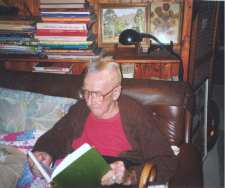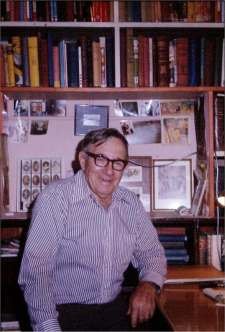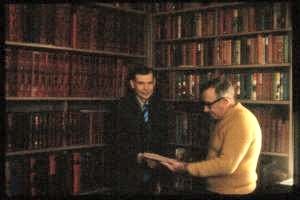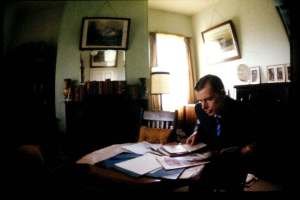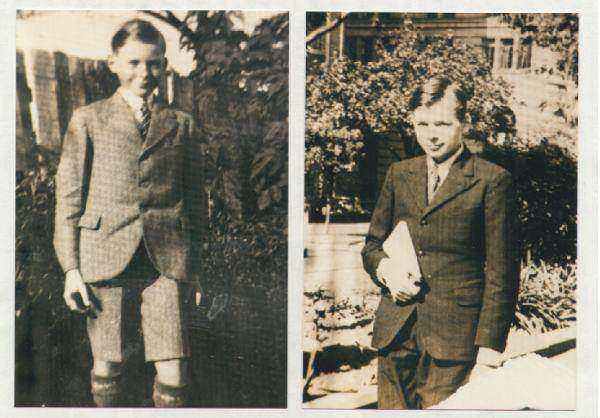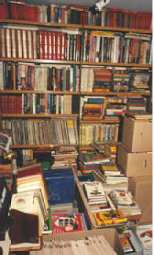| bc | Collectors of Australian
and British juvenile publications of the 20th Century,
especially English story papers, pocket libraries and
comic papers
William
'Spargo' 'Bill' Hall 1906 - 2002 John: How did you start off collecting? BILL: The old comic papers, that was the thing in the early days; all the kids had them and that's how I started off - 'Lot o Fun', 'Comic Life', 'Jester', 'Chips', 'Funny Wonder'. They were imported from England and came out in pairs, eg, 'Lot o Fun & Comic Life'; 'Jester & Funny Wonder'. In England they were sold as separate papers, probably because us colonial kids had more dough. After a period they were sold bound in six-monthly volumes with paper covers. That, too, was the period of the 'Champion', 'Magnet', 'Gem', 'Penny Popular', 'Schoolboys Own Library' and of course the 'Boys Own Annual' which came out in monthly parts until the end of the year when you got the bound volume with all the glorious folding colour plates of cricketers, trains, footballers, what have you! These coloured plates could be purchased separately from the publishers, as could postcards; James Henderson who published 'Young Folks Tales' did also; the sets I remember cost 1/- (Aust10c or UK5p) for 6 and are eagerly sought after by postcard collectors. 'Chums' also issued them.
Thomas
George Ebbage, aka 'Harry Wharton'
1924?
- 2003 Looking backwards to my earliest days, I can see that my main interests as a book reader and collector were well established by the age of 12 years. I can still remember as a child of 4 playing in the backyard a game of 'Smithy'. I would run around with arms outstretched making noises in imitation of an aeroplane engine. So I can understand now why I have collected a lot of books on famous aviators, nearly all about Australian fliers of the period between the two world wars. By the age of 8 years, my great hero was Don Bradman, and I can recall how I acted his part by hitting a tennis ball against a wall. So began my enthusiasm for test cricket which now finds expression in a library of several hundred books on the subject. The first book I learned to read was 'A Primer of Reading' in second class in the infants' school. That book was the property of the school, so I did not retain a copy, but I can still remember some of the short stories in it. 'Godfrey Gordon Gustavus Gore' was a boy who would never shut the door. There was another one entitled 'David and Goliath' a Bible story which shocked me as a child of 8. That was my introduction to the horrible subject of war, which plays such a big part in modern times. I have collected many books on the history of the First and Second World Wars, but seldom look at them these days. Another Primer story was the fable about the 'Fox and the Grapes'. "The grapes are sour," said the fox, when he failed to reach them by jumping at the wall. Never despise the things which you cannot obtain. In my eighth year I began to read the 'Sunbeams' comics in the Sydney Sunday Sun. On the front page was 'Us Fellers' by Jim Bancs. The famous characters were Ginger Meggs, Tiger Kelly, Minnie Peters and Eddie Coogan. On the back page at this time were 'Fatty Finn' by Syd Nicholls, and 'Bib and Bub' by May Gibbs. All the comics were in glorious colours on a large broadsheet of newspaper. This format ceased with the onset of the 1939-45 war. So it is not surprising that I am to this day a collector of Ginger Meggs comics from the 'Sun Herald'. I possessed several of the 'Sunbeams Annuals' as a child before the age of 10. At 6 years of age I had received for Christmas 'Collins Railway Annual'. At first I could only look at the beautiful coloured pictures in this books, but as my reading skill improved I read the stories about trains and railways of the world over and over again. So it is no wonder that I now can count a number of books and magazines on this fascinating subject in my collection. But the most treasured book of all remains the old 'Collins Railway Annual', carefully repaired with new covers when I was 17. Before I turned 8, I started to look at the picture and cartoons, and the large block advertisements in the Sydney Morning Herald and the afternoon 'Sun', and at 9 I was reading the news items on a daily basis. On of the most amusing advertisements was the 'Minties' cartoon, entitled 'It's times like these you need Minties'. Then there were the various soap advertisements, especially the comic strips, entitled "Guard against B.O with Lifebuoy". A regular was "Time for a Capstan --- 10 for 6d". The big city retailers had full page ads on Thursday and Friday afternoons with clothes reduced to SALE prices, generally ending in eleven pence half-penny. So it follows naturally that I have a collection of commemorative editions of the 'Sydney Morning Herald' going back to the nineteen thirties. I rarely saw the 'Sydney Mail' as a boy but find it a fascinating weekly paper to collect. My range of interests was further expanded at the age of 9 by the fourth class history text book. Among the stories were three on George Washington, Abraham Lincoln and James Garfield ('From Log Cabin to White House'). I was so impressed by the characters of these great men that I bought every book, magazine and paper about them which came within my view in later life. American history covers a rich and wide-ranging field and there were many other heroes to read about. The greatest of them was the President who dominated the news during my schooldays, Franklin Delano Roosevelt. I have a good range of books on FDR. It was also at the age of 9 that I first became familiar with the 'companion papers of the Amalgamated Press of Fleet Street, London. These were 'The Magnet', 'The Gem', the 'Champion' and the 'Triumph', which I changed for a halfpenny each at the local lending library at Harbord, where I went to school, and in summertime, sometimes went to the beach at weekends or during holidays. Every weekend I would read from cover to cover four to six of these boys' papers, except when I at times exhausted the stock in the library. This large amount of reading, often under poor light at night, did not adversely affect my school homework as I was generally near the top of the class, and still proudly possess two prize books for end of year examinations for fourth and sixth classes in primary school. On the contrary it appears that reading Charles Hamilton and the other authors much improved my English composition and general knowledge of history and the geography of the world, for these were my favourite subjects. As I only exchanged the story papers, I did not acquire a collection of them as a boy. When I went to high school, we moved away from Harbord at the end of First Year, and I ceased reading the companion papers as there was no lending library in my new neighbourhood. Instead of reading, I listened to the serial plays on the wireless every night.
Other early sources of enlightenment for me were the School Magazines for fifth and sixth classes, which I still possess, because my teacher did a very good job of binding them in book form. My first knowledge of the works of Shakespeare, Dickens and Shaw came from the School Magazine. In one month there was a story about Stratford-On-Avon, followed by 'Gems from Shakespeare', which was a list of famous quotations. In another issue there was an extract from the 'Pickwick Papers'. Another feature was a copy of 'St Joan', Scene 1, by George Bernard Shaw. Other short reprints were from 'A Christmas Carol' and from Lamb's 'Tales from Shakespeare'. I found the above stories so fascinating that I retained a long lasting desire for an expanded knowledge of the literature of these famous authors. At high school my class studied 'A Midsummer Night's Dream' in First Year, followed by 'The Merchant of Venice' in the following two years. I was soon able to quote lengthy passages from these plays. When I was 19 and earning a very small salary in my second job as a clerk, I remember going into Lattey's Secondhand Bookshop on the ocean front at Manly on a Saturday afternoon and asking an elderly gentleman who looked like a character out of Dickens, "Have you anything by Dickens? Charles Dickens?" "Oh yes, I know whom you mean," he replied. Soon after I walked out with a parcel of sixpenny and shilling old hardback books by the great author of the Victorian Age. I was provided with reading matter for my spare time for many months. One hardback school story book which I got as a present at the age of 9, I still possess today, and that is titled 'Dismal Jimmy of the Fourth', by John Mowbray. I liked it so much that I read it over and over again as a boy, and I still look into it in my nostalgic times. Besides several other books by Mowbray, I now own hundreds of school story books by many other famous authors, some of whom wrote for Chums and The Boys' Own Paper. I remember reading in The ABC Weekly in 1945 an article titled 'The Passing of Billy Bunter' and a few letters from readers which followed on the subject of whether Frank Richards existed or was merely an 'office signature' covering many 'ghost writers'. [Full details may be found in The Story Paper Collector, no.25, edited by the late William H Gander of Canada.] One of the letters which affirmed the existence of Frank Richards was signed by 'E C Carter', of Kingsford. Many years later I was to meet him when I got into the hobby of collecting The Magnet and The Gem. The final letter in the series came from Frank Richards himself, humorously asserting his continued existence, and his determination to go on existing as long as possible. These letters were a revelation to me. As a boy I had noticed the signatures of 'Frank Richards' and 'Martin Clifford' at the start of every Magnet and Gem story, and believed them to be two different authors. I had not sensed any similarity in the style of the stories in the two schools featured. (Greyfriars and St Jims seemed to be distinctly apart as literary works). I never thought that 'ghost writers' could also be involved. Also as a boy reader, I had not heard of the 'Red Magnet' or the 'Green Gem' of the pre-Great War period. Nor did I realise that the Gem stories I was reading were reprints of the 'Green Gem' days. In about 1950 I noticed a classified advertisement about a proposal to form an 'Old Boys Club' in Sydney. It was inserted by Mr Ernie Carter. Unfortunately I did nothing about replying because it was not convenient to attend club meetings in the City at night time, and I lost a golden opportunity to get into the hobby circle and consequently into collecting the school story papers at an early age. From 16 to 22 years my spare time after work was taken up by studying accountancy and commercial law in the evenings and at weekends. During this period I purchased very few books. I remember buying a paperback in Swain's to learn more about the life of Lincoln. The Dickens Collection was purchased for reading when I was enjoying a holiday break. After qualifying as an accountant, I found myself with some money to spend and I started to fill in my lunch hours by looking in the Sydney City secondhand bookshops. Firstly, I bought several old cricket books which were displayed in the window of the late Bert Oldfield's Sports Shop in Hunter Street. Included in this acquisition were Behind the Wicket by W A Oldfield and WG, the autobiography of W G Grace, published about 1900. Then I simply had to go and buy a new book at Swain's, on the subject of the Don. It was Bradman, by A G (Johnny) Moyes, and it cost ten shillings and sixpence [$1.05]. Soon after I began buying new paperbacks of George Bernard Shaw's plays, I recall how much I chuckled over The Doctor's Dilemma, the same as I had laughed as a boy at the antics of Billy Bunter. When I obtained a job in a state government office near Wynyard at 24 years of age, I had more money to spend on books and became a regular visitor to Tyrell's Bookshop in George Street, opposite Hunter Street.
Then one Saturday in 1969 I noticed a book review in the Sydney Morning Herald about the first Howard Baker reprint volume of the Egyptian series of the Magnets. This excited my immediate attention. I purchased a copy straightaway from Angus and Robertson Limited. As further volumes were published I continued to travel into the city to buy them, and eagerly looked for the book reviews in the Saturday papers. One review mentioned the 38 'Billy Bunter' hardback books which had been published by Charles Skilton Ltd and later Cassell's Ltd, in the period 1947 to 1963. I had until 1970 been unaware of the existence of this post-war series by Frank Richards. I soon began asking in the City secondhand bookshops for them. Mr George Greenwood's bookshop had none in stock, but I think it was Mrs Greenwood who kindly advised me to telephone Mr Stanley Nicholls of Epping. This I did as soon as I arrived home. To my delight he had about eight different titles on hand. The price was very cheap, less than a dollar each. Soon after, Mr Nicholls obtained three different years of the Greyfriars Holiday Annual: 1927, 1928 and 1929, in excellent condition for $10 the lot, and posted them out to me. Further odd Bunters and Tom Merry hardbacks followed in the post and then came the best surprise of all, a neatly wrapped parcel of about a dozen original Magnets and Gems, all in fair to good condition with covers, except for an early 1912 Gem. I was unaware that the famous green cover was missing. Indeed I had never heard of Red Magnets or Green Gems, which had been printed a long time before my school days. My next move was the insertion of an advertisement in the Herald under the classification of 'Wanted to Buy'. Of course my wants were Magnets and Gems. The first telephone call came from Mr Bill Hall. He had none of the old papers for sale, but he supplied me with a lot of information about the hobby circle in England, the clubs, and the Collectors' Digests and the Annuals. I wrote shortly after to Mr Eric Fayne and paid up 12 months subscription for airmail delivery of the CD, He also supplied me with about six back numbers of the CD Annual. These periodicals were full of wonderful material on the stories of Charles Hamilton, and I understood at last that he had invented many other schools besides Greyfriars and St Jims. Before long the advertisements of Mr Norman Shaw came to my attention and I began purchasing a lot of the original Magnets and Gems on consignment by sea mail. Other old papers, and hardcover books were soon following in the ships, and within a year or two, my sets of the Billy Bunter books and the Greyfriars Holiday Annuals were completed. About this time I called personally at Mr Stanley Nicholls' home at Epping to buy several Chums and Boy's Own Annuals, and later obtained a few more of these big books in City bookshops. From Norman Shaw I imported a number of bound volumes of the Captain, including those with the P G Wodehouse school stories. Sometime in 1970 or 1971 I was privileged to meet the late Syd Smyth (see photo above in 'Bill Hall interview). I noticed his 'wants list' in the CD or CD Annual, and found that I was able to supply him with Magnets numbers 1169 to 1174 in vg condition. This was the famous 'Brander Rebellion' series at Greyfriars. I met Syd at the entrance to Museum Station one morning about 10 or 11 o'clock. We sat on a seat in Hyde Park and exchanged Magnets. And a very generous exchange it was. Syd gave me ten for one. He had a suitcase full of Magnets from the 'Golden Age' of the 1930s. Our meeting lasted two hours and I learned a lot on the subject of Hamiltonia in that time. On my next meeting with Syd, again in Hyde Park, I was able to supply him with Magnet 450, which he had been searching for since the end of the Second World War. At one of our early meetings, Syd supplied me with all seven copies of THE GOLDEN HOURS MAGAZINE which he had edited and published in the early 1960s. I was very impressed with the high standard of this magazine, which compared favourably with similar English publications. During the second half of the 1970s Syd called at my home many times on Saturday mornings to drop in some comic annual or the latest Greyfriars Press publication and to inspect my latest acquisitions. Around 1975 I purchased a good quantity of special war issues of The Sydney Mail from a secondhand shop in Parramatta. This resulted from a helpful tip from Bill Hall, whose beautiful collection of old comics, papers and books I had previously had the pleasure of viewing. Also we had a big exchange of our duplicates, as a result of which I obtained a large run of the early CDs and a quantity of cricket books, and Magnets and Gems. It must have been around 1976 when Bill introduced me to the editor of our latest magazine, Golden Years. John - came to inspect my collection and purchase some of my duplicate Hamilton papers. In the following years he took Bill and I on a number of car tours of the Sydney secondhand bookshops and several times to the book fair at the University of NSW, so it was that I acquired a nice lot of Australiana and Americana, both hardbacks and paperbacks, mostly at bargain prices. In 1976 I bought a run of a few hundred old Jester comics from approximately 1915 to 1926 from a house in Paddington. I exchanged a lot of these comics for Ginger Meggs Sunbeams comics and annuals from Bill - and Arnold -. A collector in South Australia sold me by post three big bound volumes of Penny Populars 1919 to 1921, and two huge bound volumes of the Greyfriars Herald 1920 to 1921. Also in the mid-1970s a Melbourne schoolteacher posted me 200 copies of The Triumph from the 1930s. One of Syd's last sales to me included two bound volumes of Pluck, 1906 and 1907, containing the first St Jims and St Kits stories by Charles Hamilton, and the famous 'King Cricket' serial by Hamilton in the Boys' Realm of 1907. Editor: Ten years later I discussed the original article with 'Harry'. He had this to say: "The sad deaths of Stanley Nicholls and Syd Smyth in the 1980s greatly depleted the hobby circle in Sydney. My formidable task then was to read a considerable part of my collection in the time which remained available to me. Owing to poor eyesight that now seems impossible." Tribute It was Bill Hall who introduced me to Tom, back in the mid-1970s. Bill had come across me via a Christmas greeting to other collectors in the British publication 'Story Paper Collectors Digest' (or as it is called, 'The CD') and it was via that publication that Bill had made contact with Tom. These two hit it off well from the start, just as I did with Bill, and later, Tom. Though neither drove and had to rely upon public transport, a number of 'trades' had been done. One memorable Spring day it was arranged that I would pick up Bill, who lived at Hammondville, a retirement suburb close to the George's River about 20 miles southwest of Sydney, and continue over to Tom's place at St John's Park about 8 miles further west. This area has changed out of sight over the past decade and new arrivals would not believe that much of the area was once occupied by 5-acre properties. Many of these held horses owned by city dwellers and so I was intrigued by the drive off the main road and down the dirt track to the house in which Tom lived. This was a delightful old homestead with a verandah on three sides, tall windows with push-out skylights and a large door with imposing brass knob. Tom greeted us with firm handshakes and escorted us into the 'book room', the front room on the left. My jaw dropped upon entry as I'd never seen so many books in one room! From that day on we three became firm friends, lifetime friends with rarely a week or two going by without one of us speaking to the other on the phone. Such is the way of collectors with similar interests. Soon after I offered to drive Bill and Tom around to bookshops, charity shops and anywhere books and magazines were likely to be found. Two decades ago and long before rents pushed such small turnover businesses out of the city and even the suburbs, one could find likely spots by the dozen. Though Bill was retired, Tom was a tax accountant and I a clerk in a government department, so our 'tours' were usually confined to Saturdays or when I had holidays. Our favourite 'haunt' was the Salvation Army 'White Elephant' as the old ex-cinema next to Chatswood Station was called. From here we would come out carrying loads of material, enough often to fill the boot of my car! Often we'd sit in a nearby park while Tom, a vegetarian, would juice a number of oranges. With three like souls driving around together, there would be continuous talk and no dull moments in the day. Often we'd meet other collectors and come across memorable characters. One event is worthy of note. Tom was first and foremost a collector of Bradman memorabilia and to this end was on a continual search for copies of 'The Sydney Mail' which often ran stories on The Don. He'd been reliably informed that a chap living in the long-since abandoned Lilyfield Tram Depot had a number for sale. Whether or not said chappy was a caretaker or just a vagrant 'living rough' we never knew. I can vividly remember the 'event'. The old depot was a long, rectangular building with a glassed-in side entrance. Both sides of this entrance were walled in with Readers Digest condensed books which no doubt worked wonders as insulation. We entered the main building, the entryway of which was blocked by a long counter. A dim light shone from between wooden shelving in the middle of the long, black and bare shell of the depot. An old chap, I couldn't describe him, shuffled over to the counter and bid us come over to the lighted area after working our way around the counter. As we approached the light, it became apparent that it was indeed a candle in a holder, which sat on a table or crate amid a sea of books and magazines, most of which had fallen from the shelving and slid up against a bed, or mattress. Imagine if you will a skateboard rink with curved sides, a bed in the middle with books and mags on all slopes, up again the bed. That's how it appeared, and all was dirty and unkept. One might well suppose that a spark from the candle would send the lot up. The price wanted for the 'Mails' was well over the top so we came away with just a lingering memory of the day. During the 1980s it was Bill and Tom who encouraged me to publish a regular private magazine on our interests, and 'Golden Years' was born. At this time Tom was buying large quantities of books and papers from Norman Shaw in London and each trip I made to the homestead seemed to indicate that the book room would soon burst. Bookcases rose to the ceiling and there was little room to move between them. In the room across the hall was a 'wall' of packages, many with the books still in them. For some time I was remiss is visiting Tom but one day called in, having been advised that there were 'changes' to the area. Changes, indeed; I found a shopping centre under construction and all the roads changed and after many wrong turns, came to the rear of the house via a new street. This was rather a shock and my home eventually suffered the same fate, though not of such a drastic nature. Eventually Tom moved away from Sydney to a coastal village and I did not envy those poor souls who had to pack and move the collection. Having done the same myself at the end of 2001, it comes as a great shock to anyone who having lived in the one spot for decades, has to pack and move. Bill Hall also moved house, not long after losing his wife and selling his first collection, but in his case it was only across the road and along half a block. Tom passed away 23rd August, 2003 after a rapid deterioration in his health. I visited him two weeks previously and it seemed, in his own opinion, that he had little longer to live despite, as he remarked, "remaining a vegetarian for the past 60 years". He had experienced an almost total loss of sight and, at that stage, mobility. With Tom's passing, I've lost a true friend and mate. Even at the end of his life, Tom could still list all Australian prime ministers and US presidents in order, as he proved on that final visit. A highly intelligent gentleman, a gentle man, friendly with a twinkle in his eye and never a bad word to say about anyone, I doubt that I shall ever see his like again. Tom and Bill, I salute the pair of you. Eric Victor Copeman 1917 - 1978 My name is Robert Copeman and I am the son of Eric Victor Copeman, who was a member of the Golden Hours book club, along with Vic Colby, Betty Pate, etc, years ago. At one period the book club meetings were actually held at my dad's home in Marrickville NSW. My father passed away in February 1978 and his book collection was sold to various book club members and libraries at the time. My dad originally possessed a very large book collection, which included Sexton Blake, The Baron, Hammond Innes, Billy Bunter and various others. He also was fortunate enough to personally meet the author John Creasy in Sydney NSW, when John Creasy was visiting Australia years ago. He also wrote short stories himself and sold several of them here in Australia and overseas. He also collected destination boxes and rolls from the Sydney trams and had three destination boxes and several original tramway destination rolls from the Sydney and Newcastle tram systems. From what he told me, his interest in books, etc, went right back to his childhood days.
She married Vic Colby in later
years and was also the sister or Michael Pate, who used
to star in the Australian series of "Matlock
Police". My dad mentioned Ernie Carter & Stan
Nicholls, though I don't remember them. They were
probably all around at our place at Marrickville in the
1950's, but being a young child, I was put to bed early
and didn't get to see them. My mother would have known
them all also. Unfortunately, she passed away in 1962. #
Recommended
reading Back to Collecting Books & Magazines Main A-Z Index Email the CB&M editor, John, for corrections, additions or queries. |
bc |
